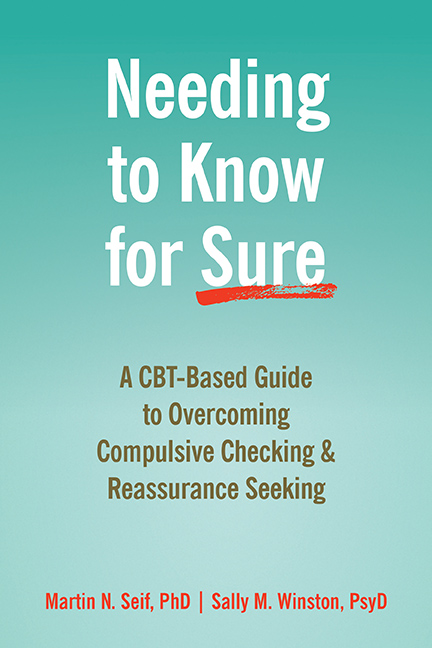By Martin N. Seif, PhD, and Sally M. Winston, PhD, coauthors of Needing to Know for Sure
When confronted with uncertainty, it is natural to seek some reassurance that our solution is reasonable, rational, “makes sense,” or otherwise good enough. We all seek out the type of reassurance that works well to calm a doubt, allay a worry, solidify a plan of action, or guide a decision.
However, people with anxiety or obsessive compulsive disorder (OCD) sometimes get caught in a relentless quest for reassurance; never feeling satisfied enough to move on. This can cause endless internet “research,” provoke repetitive checking behaviors, alienate friends and family with reassurance-seeking conversations, and—perhaps most distressing—trigger constant, looping internal “debates,” where “what-ifs?” and “rational responses” alternate and never stop. Being stuck in reassurance-seeking can lead to paralysis in decision-making, haunting worries about making a mistake or causing harm, insecurity, and self-doubt.
Searching for reasons why you have become stuck is almost no help—and more often than not actually increases the internal debate. Instead, it is more helpful to recognize that the need for reassurance stems from a profound intolerance of uncertainty. Freeing oneself from the trap of unproductive reassurance requires learning to tolerate doubts by interrupting the factors that initiate and maintain the process.
There are three processes that make uncertainty feel so intolerable: anxious thinking distorts risk assessment; paradoxical effort makes attempts to eliminate uncertainty work backwards; and negative reinforcement drives the cycle.
It may not be obvious, but certainty is a feeling, not a fact. If you think about it, no one can be absolutely sure about anything. Here is an illustration: Does your car have a flat tire right now? How can you be certain? How long since you checked? Could something have happened since then? Actually, you only feel sure of your answer.
The key is that unproductive reassurance-seeking is an attempt to feel sure, to abolish all doubts, to establish certainty as a fact. Yet absolute certainty is unattainable and unnecessary to make decisions, evaluate choices, and take actions. Anxious people can get caught up in doubts about anything, including one’s own motives, identity, health, and sanity (as well as those of others). There are no guarantees possible about the future. Refraining from needless reassurance is easier when there is a shift in attitude, a willingness to feel uncertainty, and the acceptance of doubt and its discomforts.
So why does it become so difficult for some of us to avoid the reassurance trap?
First, your brain can make uncertainty look dangerous. When certain thoughts trigger your amygdala and the associated alarm systems, an altered form of consciousness that we call anxious thinking arises. The world seems riskier and more threatening, and ambiguity looks like danger. A catastrophic thought can become as frightening—and feel as dangerous—as some catastrophic behaviors or events. The mind gets stickier. Anxious thinkers get hijacked by their own imagination. Doubts seem like red flags or messages that seem to demand attention.
Second, paradoxical effort makes the attempt to control these worrisome thoughts backfire. Unlike how effort works in the external world, urgent effort to control your thoughts works backwards. The more you try to stop an upsetting thought, the more it intrudes. (Try not to think of a pink elephant.) Efforts to distract, push away, argue with, reassure, or “get just one more bit of information” have the effect of strengthening doubts instead of resolving them.
Finally, negative reinforcement is the engine that drives the ongoing looping thought process. Research psychologists have long demonstrated that positive reinforcement (or a reward) can strengthen a targeted behavior, whether that reward is food, a kind “thank-you,” or a warm hug: an increase in pleasure defines a reward. Similarly, decreasing unpleasure—examples are the reduction of pain, stress, or anxiety—works to reinforce responses in exactly the same way in the brain.
The temporary reduction in anxiety that occurs with unproductive reassurance actually reinforces worrying thoughts that preceded it. The compulsive need for certainty increases, and the reassurance trap is tightly set.
It is important to realize that there are a multitude of forms of reassurance seeking, and many are quite subtle. These include hidden or covert checking, such as constant texting, analyzing the look on someone’s face to search for cues, asking others for empty reassurance in the form of “tell me everything will be fine,” and repetitive positive self-talk and reassuring self-predictions about the future—all in the service of trying to banish doubts.
In Needing to Know for Sure, we introduce a four-step program for breaking out of this trap and learning to tolerate reasonable uncertainty in your life. The four mindful steps are: 1) Distinguish doubts or distress from true danger; 2) Embrace the feeling of uncertainty; 3) Avoid reassurance; and 4) Float above the feeling while letting more time pass. You can remember these steps as DEAF, and these steps work independently of the content of your worrisome, doubting thoughts.
People can learn to become DEAF to the beckoning of a reassurance trap and the anxiety-producing bullies in their mind. They can turn a DEAF ear to the false alarm signals that are crying, “Emergency! You need to check this out right now!” It can teach your brain that thoughts are just thoughts, and that doubt is part of every decision and judgment you make, and is both inevitable and unavoidable.
Martin N. Seif, PhD, is cofounder of the Anxiety and Depression Association of America (ADAA), and was a member of its board of directors from 1977 through 1991. Seif is former associate director of the Anxiety and Phobia Treatment Center at White Plains Hospital, a faculty member of New York-Presbyterian Hospital, and is board certified in cognitive behavioral psychology from the American Board of Professional Psychology. He maintains a private practice in New York, NY; and Greenwich, CT; and is coauthor of What Every Therapist Needs to Know About Anxiety Disorders and Overcoming Unwanted Intrusive Thoughts.
Sally M. Winston, PsyD, is founder and codirector the Anxiety and Stress Disorders Institute of Maryland in Towson, MD. She served as the first chair of the ADAA’s Clinical Advisory Board, and received their prestigious Jerilyn Ross Clinician Advocate Award. She is a master clinician who has given sought-after workshops for therapists for decades. She is coauthor of What Every Therapist Needs to Know About Anxiety Disorders and Overcoming Unwanted Intrusive Thoughts.



 2024 Peace Playbook: 3 Tactics to Avoid Clashes with Your Partner
2024 Peace Playbook: 3 Tactics to Avoid Clashes with Your Partner